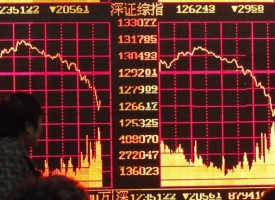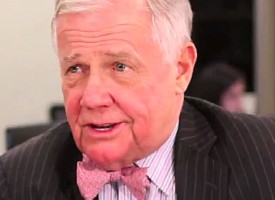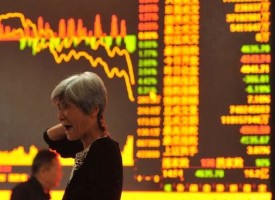As we come to the end of what has been a volatile week of trading in which gold and silver strengthened and the dollar weakened, here is where things stand.
July 21 (King World News) – Here is what Peter Boockvar noted as the world awaits the next round of monetary madness: Succinct Summation of the Week’s Events:
Positives
1) Initial jobless claims fell 15k w/o/w to 233k and that was 12k below the estimate. This lowered the 4 week average to 244k from 246k. Continuing claims however, delayed by a week, rose by 28k to the highest level in 3 months.
2) After falling by 13% last week, refi applications rebounded by 13% w/o/w as mortgage rates held steady at 4.22%. Refi’s are still down 52% y/o/y. Purchase applications were up 1.1% after dropping by 2.5% last week and are up 6.7% y/o/y.
3) Housing starts in June totaled 1.215mm, 55k more than expected and May was revised up by 30k to 1.122mm. The most this year was back in February when it reached 1.288mm. Single family starts totaled 849k, up 50k. The top in this cycle was back in February when it reached 877k. The 2006 peak was 1.82mm and the 25 year average is 1.027mm. Multi family starts were 366k, up 43k. It touched 460k back in December but these levels are more in line with long term averages. Permits also surprised to the upside as they came in at 1.254mm in June, 53k more than expected. Single family permits rose 32k m/o/m to 811 and multi family was higher by 54k to 443k.
4) Foreigners were back buying US notes and bonds with net purchases of $46.4b in May. The buyer makeup though was bifurcated as central banks were sellers again while private participants were big buyers. Specifically with notes and bonds, Asian countries were net sellers while Europe and the Caribbean (aka, hedge funds) were buyers. For the 3rd straight month China was a seller of notes and bonds of $9.2b but offset that with purchases of t-bills which brought their net purchases to $10b. Hong Kong, a possible conduit for mainland selling, sold $8.7b of notes and bonds. Japan sold $3.3b of notes and bonds but offset that with t-bill purchases. Participants in the Cayman Islands, a hedge fund conduit, were buyers of $34.8b of notes and bonds and thus dominated the buying out of that region.
5) The NABE in their Q2 Business Conditions survey said things did improve from Q1 but what was most noteworthy were the comments on the labor market. They said “Materials cost pressures appear to be easing, but more firms are facing higher labor costs and difficulty in hiring, especially skilled labor…Pricing power, or lack of it, and labor costs are generating some headwinds for a significant number of firms.” Their Net Rising Index (NRI) on wages was the best since January 2016. Passing these costs on to the rest of us was mixed as current plans for “prices charged continued its recent upward trend” but “respondents’ expectations for prices over the next three months suggest price increases will become less widespread.”
6) Import prices remained modest in June but will that change from here with the weakening dollar? Prices fell .2% m/o/m in June as expected but May was less negative by two tenths and thus the y/o/y gain of 1.5% was more than forecasted.
7) Japanese exports rose 9.7% y/o/y, a touch above the estimate of up 9.5% while imports jumped by 15.5% y/o/y vs the forecast of up 14.4%. On a merchandise volume basis, exports were up by 4% with the best gain to China that saw volume exports rise by 14.2%. Volume growth to the US was up by 5.2%.
8) The Chinese economy grew 6.9% y/o/y in Q2 just as it did in Q1 and that was one tenth more than forecasted. In the last month of Q2, retail sales, industrial production and fixed asset investment all beat estimates. But, watch out for those ‘gray rhinos’!
9) Facing shrinking real wages, the UK citizen got a respite in June as CPI was reported flat m/o/m instead of rising by .2% as expected. Versus last year headline prices are still up 2.6% and 2.4% at the core. Wholesale prices did rise more than expected as PPI was up 9.9% y/o/y vs the forecast of up 9.4% but it is a slowdown from the 12.1% spike in May. Margins also are still getting squeezed as output prices were up by 3.3%.
10) Notwithstanding the real wage squeeze in the UK, retail sales ex fuel in June was a bit better than expected with a .6% rise m/o/m vs the forecast of up .4% and which comes after a 1.1% drop in May. The Office for National Statistics said “A particularly warm June seems to have prompted strong sales in clothing, which has compensated for a decline in food and fuel sales this month.”…
IMPORTANT:
To find out which company the richest man in China has invested in, one that
Rick Rule and Sprott Asset Management are pounding the table on that
is quickly being recognized as one of the greatest investment
opportunities in the world – CLICK HERE OR BELOW:
Negatives
1) The BoJ and ECB continue on their scorched earth policy of wanting higher inflation that if achieved would result in a spike in interest rates and without wage growth would damage economic growth. While we expect a continued ratcheting down of QE from both, the blind reliance and persistence on policy that has failed in its objective (and which has created massive side effects) reminds me of this, https://www.youtube.com/watch?v=SVY7w9DqZ_A. (h/t RH). To confuse us this week, both the euro and yen are higher while yields in both regions are down on the week. Look at the chart in the DAX on this strengthening euro.
2) The Philly manufacturing index for July fell to 19.5 from 27.6 and that was 3.5 pts below expectations. The internals however were even softer than the headline figure. New orders fell to just 2.1 from 25.9 and is now well below the 6 month average of 26.2. That is the weakest since August when it printed -3.4. Backlogs fell 7 pts to 7.2 after rising by 5 pts last month. Shipments are at the lowest level since September. Inventories went from 5.8 to .7. Employment dropped by 5.2 pts to 10.9, the lowest since December and the Workweek dropped by 16.7 pts to just 3.8, the weakest since November. Positively, the business activity 6 month outlook did improve by 5.6 pts to 36.9, a 3 month high but this touched 59.5 back in March.
3) The July NY manufacturing index fell 10 pts m/o/m to 9.8 and that was below the estimate of 15. New orders fell almost 5 pts to 13.3 and backlogs dropped by more than 9 pts to back below 50 at -4.7. Shipments halved, giving back all of the jump in June. Employment dropped by 3.8 pts to a 5 month low at 3.9 while the Workweek was zero, down from 8.5. Inventories dropped by 5.3 pts to 2.4. The 6 month business activity outlook fell by almost 7 pts to 34.9, the weakest since November. Capital spending plans fell 5.8 pts and almost giving back all of June’s rise. In July “Business activity grew modestly in New York State” according to the NY Fed.
4) The NAHB July builder sentiment index fell to 64 from a revised 66 in June (from 67). This is 3 pts below the forecast and is now just 1 pt above the pre election level of 63 seen in both October and November. One of factors causing some builder angst is the increasing concern “over rising material prices, particularly lumber. This is hurting housing affordability even as consumer interest in the new home market remains strong.” The side effect of our trade policy. Both current conditions and future expectations fell 2 pts. Prospective Buyers Traffic fell 1 pt to 48.
5) From late last Friday, C&I loans for the week ended July 5th slowed to a 1.4% y/o/y growth rate vs 1.8% last week. This growth was 7% in 2016. On an absolute dollar basis, C&I loans outstanding are no different than they were in late October. All bank loans and lease growth slowed to 3.1% y/o/y vs 6.1% last year.
6) Investor confidence in the Germany economy cooled a bit in July. The ZEW index fell to 17.5 from 18.6 and that was slightly below the estimate of 18. Current Conditions moderated by 1.6 pts to 86.4 vs the estimate of no change. As the numbers were only down a touch, the ZEW said “The outlook for German economic growth in the coming 6 months continues to be positive.”
7) On a y/o/y basis, 70 of 70 cities surveyed saw price gains for new apartments in a bubble that just won’t quit. For existing ones, the score was close to perfect with 66 saying up. Versus last month, 60 of 70 cities saw price gains for new stuff vs 56 in May while 60 of the used product reported priced increases, the same number as the month prior. Price gains continued to cool in the big cities. In Beijing, prices were up ‘just’ 10.7% y/o/y vs 13.5% in May. Shanghai saw prices higher by 8.6% vs 11% last month while prices in Shenzhen were up only 2.7%, half the pace as the month prior. Last June, prices in Shenzhen were higher by 47% y/o/y. While prices in their largest cities slowed down, they instead picked up in smaller cities in one big game of whack a mole.
8) The Chinese proxy that is Australia said 14k net jobs were created in June, a hair less than the estimate of 15k while May was revised down by 4k. The unemployment rate held at 5.6%.
9) As my readers know I like to inject the occasional pop culture (see Belushi above) into my work and as a music fan I was sorry to hear about the passing of Chester Bennington, lead singer of Linkin Park. This was my favorite song of theirs, https://www.youtube.com/watch?v=n1PCW0C1aiM. “And the shadow of the day, will embrace the world in gray. And the sun will set for you.”
***ALSO JUST RELEASED: Look For This Important Catalyst In The Gold Market CLICK HERE.
© 2017 by King World News®. All Rights Reserved. This material may not be published, broadcast, rewritten, or redistributed. However, linking directly to the articles is permitted and encouraged.








